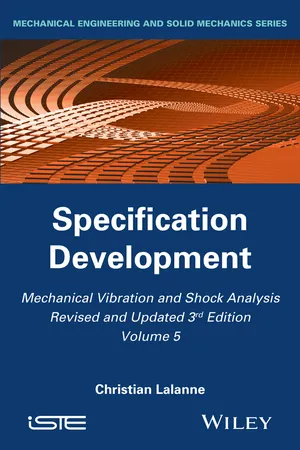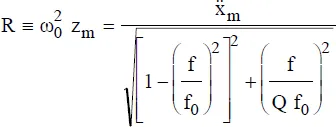
- English
- ePUB (mobile friendly)
- Available on iOS & Android
Mechanical Vibration and Shock Analysis, Specification Development
About This Book
Everything engineers need to know about mechanical vibration and shock...in one authoritative reference work!
This fully updated and revised 3rd edition addresses the entire field of mechanical vibration and shock as one of the most important types of load and stress applied to structures, machines and components in the real world. Examples include everything from the regular and predictable loads applied to turbines, motors or helicopters by the spinning of their constituent parts to the ability of buildings to withstand damage from wind loads or explosions, and the need for cars to maintain structural integrity in the event of a crash. There are detailed examinations of underlying theory, models developed for specific applications, performance of materials under test conditions and in real-world settings, and case studies and discussions of how the relationships between these affect design for actual products.
Invaluable to engineers specializing in mechanical, aeronautical, civil, electrical and transportation engineering, this reference work, in five volumes is a crucial resource for the solution of shock and vibration problems.
This volume focuses on specification development in accordance with the principle of tailoring. Extreme response and the fatigue damage spectra are defined for each type of stress (sinusoidal vibration, swept sine, shock, random vibration, etc.). The process for establishing a specification from the life cycle profile of equipment which will be subject to these types of stresses is then detailed. The analysis takes into account the uncertainty factor, designed to cover uncertainties related to the real-world environment and mechanical strength, and the test factor, which takes account of the number of tests performed to demonstrate the resistance of the equipment.
Frequently asked questions
Information
Chapter 1
Extreme Response Spectrum of a Sinusoidal Vibration
1.1. The effects of vibration

1.2. Extreme response spectrum of a sinusoidal vibration
1.2.1. Definition

1.2.2. Case of a single sinusoid
1.2.2.1. Excitation defined by acceleration







Table of contents
- Cover
- Table of Contents
- Title Page
- Copyright
- Foreword to Series
- Introduction
- List of Symbols
- Chapter 1: Extreme Response Spectrum of a Sinusoidal Vibration
- Chapter 2: Extreme Response Spectrum of a Random Vibration
- Chapter 3: Fatigue Damage Spectrum of a Sinusoidal Vibration
- Chapter 4: Fatigue Damage Spectrum of a Random Vibration
- Chapter 5: Fatigue Damage Spectrum of a Shock
- Chapter 6: Influence of Calculation Conditions of ERSs and FDSs
- Chapter 7: Tests and Standards
- Chapter 8: Uncertainty Factor
- Chapter 9: Aging Factor
- Chapter 10: Test Factor
- Chapter 11: Specification Development
- Chapter 12: Influence of Calculation Conditions of Specification
- Chapter 13: Other Uses of Extreme Response, Up-Crossing Risk and Fatigue Damage Spectra
- Appendix
- Formulae
- Bibliography
- Index